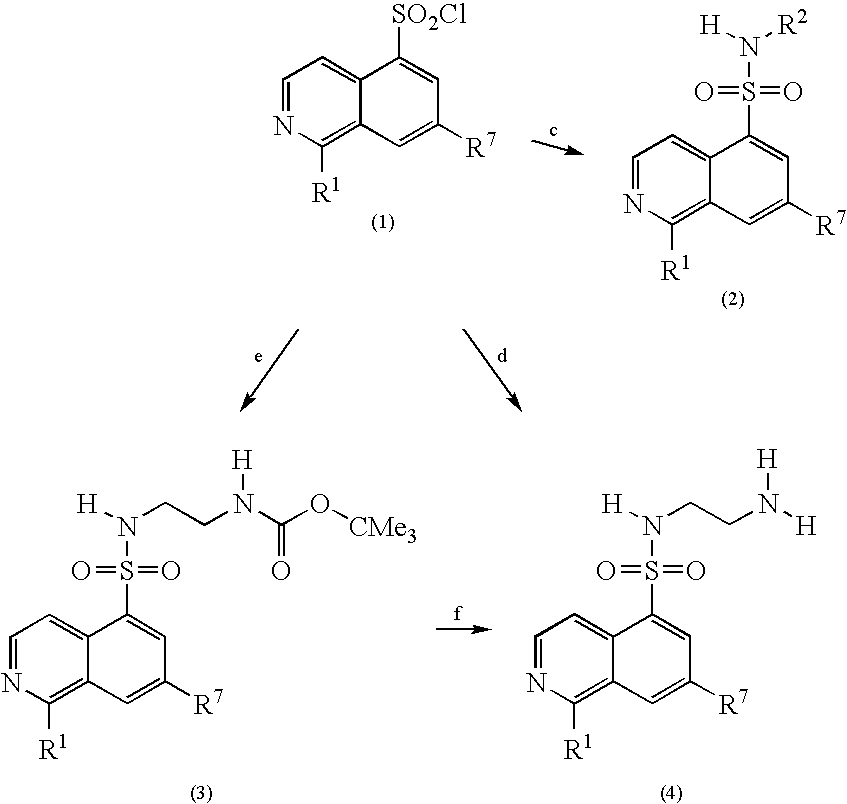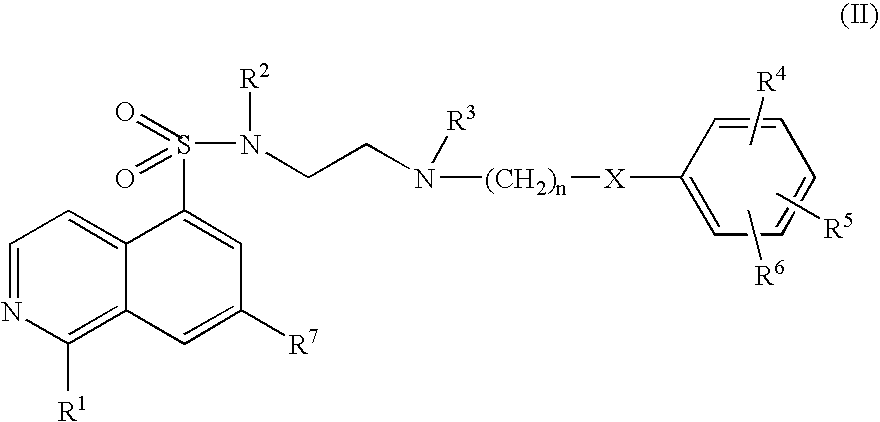Inhibitors of Akt (protein kinase B)
a technology of protein kinase and inhibitors, which is applied in the direction of heterocyclic compound active ingredients, biocide, drug compositions, etc., can solve the problems of hcmv abortive production, early death, and stunted growth of littermates
- Summary
- Abstract
- Description
- Claims
- Application Information
AI Technical Summary
Benefits of technology
Problems solved by technology
Method used
Image
Examples
preparation 1
Isoquinoline-5-sulfonyl chloride hydrochloride
[0117]Anhydrous DMF (1.5 mL) is added dropwise to a stirred suspension of isoquinoline-5-sulfonic acid (28.3 g, 135 mmol) in thionyl chloride (150 mL, 2.06 mole) at ambient temperature under nitrogen. The resultant mixture is heated to reflux for 2.5 hours. After being cooled to ambient temperature, the mixture is concentrated under vacuum to give a yellowish powder. The powder is suspended in dry CH2Cl2 (200 mL), sonicated, filtered and dried at 40° C. under vacuum to give 29.2 g (111 mmol, 82% yield) of the title compound. 1H NMR (TFA-d1): δ8.48 (t, J=7.9 Hz, 1H), 9.13-9.14 (m, 2H), 9.29 (d, J=7.9 Hz, 1H), 9.57 (d, J=7.0 Hz, 1H), 10.26 (s, 1H).
preparation 2
Isoquinoline-5-sulfonic acid (2-amino-ethyl)-amide
[0118]Powdered isoquinoline-5-sulfonyl chloride-hydrochloride (5.57 g, 21.1 mmol) is added in small portions to a stirred solution of ethylenediamine (45.0 mL, 673 mmol) in CHCl3 (400 mL) at ambient temperature under nitrogen. The resultant mixture is stirred for 1 hour. After filtration and concentration in vacuo, the crude product is chromatographed on silica (gradient 5-10% CH3OH in CH2Cl2, then 0-16% 2M NH3 / CH3OH in CH2Cl2) to give 4.71 g (18.7 mmol, 89% yield) of the title compound. ESIMS: m / z 252 (M+H)+.
preparation 3
(2-bromo-phenoxy)-acetic acid methyl ester
[0119]Powdered potassium carbonate (3.84 g, 27.8 mmol) is added to a stirred solution of 2-bromophenol (3.20 g, 18.5 mmol) and methyl bromoacetate (3.11 g, 20.3 mmol) in anhydrous DMF (20 mL). The resultant mixture is stirred at ambient temperature under nitrogen for 16 hours. Water (140 mL) and EtOAc (120 mL) are added to the mixture and the two-layered solution is stirred vigorously for 3 minutes. The organic layer is separated, dried over MgSO4, filtered and concentrated. The crude product is chromatographed oh silica (gradient 2-8% EtOAc in hexane) to give 4.39 g (17.9 mmol, 97% yield) of the title compound. EIMS: m / z 244 (M+, 79Br), 246 (M+, 81Br).
[0120]Using a procedure similar to Preparation 3, with the appropriate starting materials, the following compounds may be prepared and isolated.
[0121]
Prep. #CompoundData4(2-chloro-phenoxy)-acetic acidEIMS: m / z 200(M+, 35Cl), 202(M+,methyl ester37Cl).5(2-methyl-phenoxy)-acetic acidEIMS: m / z 180...
PUM
| Property | Measurement | Unit |
|---|---|---|
| temperature | aaaaa | aaaaa |
| temperature | aaaaa | aaaaa |
| temperature | aaaaa | aaaaa |
Abstract
Description
Claims
Application Information
 Login to View More
Login to View More - R&D
- Intellectual Property
- Life Sciences
- Materials
- Tech Scout
- Unparalleled Data Quality
- Higher Quality Content
- 60% Fewer Hallucinations
Browse by: Latest US Patents, China's latest patents, Technical Efficacy Thesaurus, Application Domain, Technology Topic, Popular Technical Reports.
© 2025 PatSnap. All rights reserved.Legal|Privacy policy|Modern Slavery Act Transparency Statement|Sitemap|About US| Contact US: help@patsnap.com



